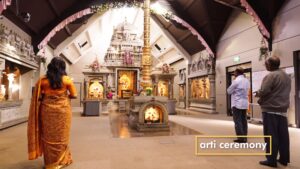A young Hindu called Pranathi explains how all the items on a puja tray are used during worship.
Curriculum Mapping
Component 1: The study of religions: beliefs, teaching and practices: Hinduism - Different forms of worship: puja and arati - The rituals of puja and arati and their significance for Hindus.
Area of Study 2 – Hinduism - Section 3: Living the Hindu Life - The nature and purpose of prayer in the temple and the home: the nature, features of use and purpose of the different forms of worship, including meditation, puja, havan, darshan, arti, bhajan, kirtan and japa, with reference to interpretations of Bhagavad Gita 6.44–47; divergent understandings of the benefits for Hindus of having different forms of worship.
Component Group 1 - Beliefs and teachings & Practices - Hinduism - Approaching deity •Different Hindu understandings of the role,forms and importance of the following types of worship: •• Havan or homa •• Puja •• Meditation •• Japa •• Bhajan or kirtan •• Darshan • The nature and importance of sacred places and spaces for Hindu worship: •• Temples •• Shrines •• Sites of pilgrimage •• Outdoors •• Hills and rivers
2.1 Unit 1 PART A - Hinduism - Core beliefs, teachings and practices - Practices Worship Features and importance of daily puja in the home: (Bhagavad Gita 3:19, 4:38) Features and importance of congregational puja in the mandir (including devotions to the murti, arti and havan) Diversity in Vaishnavite and Shaivite worship Significance of bhakti Role, importance and features of pilgrimage to Varanasi
2.3 Component 3 (Route A) - Option 2: Hinduism - Places of worship in Britain and elsewhere ➢ Features and importance of daily puja in the home ➢ Features and importance of congregational puja in the mandir ➢ Diversity of views and practices: Vaishnava and Shaiva bhakti ➢ Hindu mandirs in Britain compared to those in India ➢ Features and importance of worship at outdoor shrines Worship/meditation ➢ The significance of different forms of worship/meditation; havan, puja, arati, darshan Bhagavad Gita 9.26, bhajan/kirtan, japa: Bhagavad Gita 3.19, 4.38, 6.11–12 ➢ The importance of focuses of worship and representations of the divine; one god, other deities, holy land, plants and animals: Bhagavad Gita 16.24 ➢ Honouring Gurus and elders
Transcript
Holy Cribs – The Vimana and Puja Tray
Pranathi: A murti is a statue of a deity, a god or goddess. And Hindus like me use these to help us worship. This is Ganesha, the elephant headed God of wisdom, and he has his own vimana or shrine, which is a small space dedicated to him containing all the things we use to worship him. The murti's are treated as honoured guests and they'll be washed, decorated and given offerings of food every day as signs of respect to the deities they symbolise. Each one of the deities represents one aspect of the personality of the one unseen spirit. Brahman Puja is the name we use for worship or prayer. We often use a tray to hold all things we use in puja. There might be fruit, rice, flowers. Water, a lamp, ash, Kumkum, powder, incense, a bell, all kinds of things to touch, taste, smell here and look at. All five senses are involved as a symbol that the whole person is devoted to the deity. We ring a bell to wake up the murti and to bring people to join in the puja. We have a lamp because light symbolizes enlightenment or understanding. We often use a lamp that burns ghee, which is clarified butter and it smells great. Incense smells great, too. And we burn it in the Mandir and in our homes to purify the air, hiding any nasty smells. It also creates the sort of atmosphere that I've grown up associating with worship. So it helps me get in the right frame of mind. The flowers also smell nice and bring color to the Vimana. A water pot called a kamandalu, and the spoon are used to wash the muthi. And a red powder called kumkum and sandalwood paste are used to anoint the muthi and to make the tilaka marks on our foreheads to show we have been blessed. Prasad is food like fruit nuts or sweets that are offered to the murthis and then shared out to the worshippers after puja. We believe that the deity blesses the food during the puja, so when we eat the Prasad, we receive the blessing.








